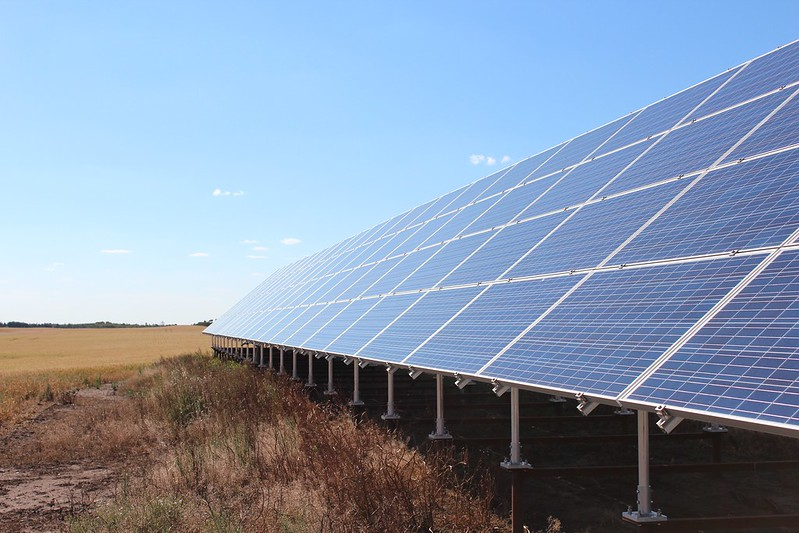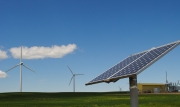Signed into law in August, the U.S. Inflation Reduction Act (IRA) has been heralded as the biggest single piece of legislative action aimed at fighting climate change that the world has ever seen. It is worth remembering, though, that the huge IRA is not just one policy — but many — and will touch multiple sectors in the months and years ahead. Here, we focus on what the IRA means for clean energy in the U.S., which — like Canada — has committed to a net-zero electricity grid by 2035.
The first thing to say is that Washington has gone big on cash, and we mean big. With US$369 billion dedicated to direct investments and tax credits, the IRA represents the single largest investment into climate and clean energy in history. This includes several provisions to support investments in clean electricity solutions, such as:
- $30 billion in production tax credits to boost domestic manufacturing of wind turbines, solar panels, batteries, and critical minerals processing for EVs.
- A base credit rate of 0.3 cents per kilowatt-hour for production of clean electricity, which will increase to 1.5 cents per kilowatt-hour if a qualified facility meets the prevailing wages requirement (meaning they pay their workers fairly based on local standards for industry wages).
- Billions of dollars for clean energy infrastructure, including $2 billion in the form of loans for transmission projects. This can assist with the construction of transmission lines that connect different regions.
- $30 billion in targeted grants and loans to help states and electricity utilities companies transition to clean electricity.
- Investment tax credits for battery and other energy storage systems, which are projected to lower capital costs for those projects by around 30 per cent.
In short, there is no incrementalism when it comes to the money. All told, the White House says the IRA will result in the installation of 950 million solar panels, 120,000 wind turbines, and 2,300 grid-scale battery plants by 2030. As a result, by 2030, electricity sector emissions are expected to decline 70 to 75 per cent below 2005 levels.
The message is clear here: this huge injection of cash is intended to demonstrate the U.S.’s confidence in renewables and the other clean energy technologies upon which a net-zero grid will rely. It is making plain its belief that investment in a clean grid will pay back dividends in both emissions reductions and economic development (more on the second bit later).
We at the Pembina Institute would certainly agree with that. Our research shows that a modernization of our grid — basing it on a mix of renewables, storage, demand-side management, efficiency measures and transmission improvements — can produce reliable net-zero electricity for Canadians. The opportunities here, in decarbonizing not just our electricity supply, but so many of our growing electricity end-uses (think: EVs), are certainly worth investing in — whether it is public or private investment that does most of the legwork.
Economic benefits
But there’s more to the IRA’s electricity measures than *just* getting the U.S. well on its way to a net-zero grid. According to early modelling, these measures will cause the retail cost of electricity for U.S. consumers to decline by 5.2 to 6.7 per cent over the next decade, resulting in average household savings of $170-$220 per year. This should be appealing to policymakers everywhere, given the current double-whammy of inflation and spiraling natural gas prices that are likely to see more and more households in North America fall into energy poverty this winter.
Equally promising is the jobs revolution that the IRA looks likely to spur. All that clean tech investment will birth a generation of designers, manufacturers, engineers, and installers — with over 5.7 million job-years being created in the U.S. electricity space (a job-year is one job, for one person, that lasts one year). The IRA also incentivizes companies to pay these people fairly: if they do not meet prevailing wage requirements, they will be limited to accessing only 20 per cent of production or investment tax credits.
This is a great example of policy that seeks to modernize the grid, get down emissions, and bring communities along with it – which is the final piece of the puzzle in ensuring an equitable transition. As the Pembina Institute has long argued, transforming our energy production is a chance for us to re-set some of the imbalances in our economy, and bring workers into the energy space who have typically not experienced the industry’s economic benefits. Through creating huge demand for whole new types of jobs overnight — like solar panel specialists, for example — the IRA creates a chance to address old biases about who does what, and give access to people such as women, people of colour and Indigenous peoples, who might have faced barriers to participating in the energy sector in the past.
Another good example of this is provisions designed to support communities that will need more support — towns with large concentrations of coal workers, for example. The IRA gives an additional 10 per cent tax credit to projects located in communities that have previously relied on extractive and fossil fuel industries. As our research on the coal phase-out in Canada has shown, this kind of additional funding can help spur local economic development — creating jobs and revenue streams for local governments — in communities that are impacted by the retirement of fossil-fuel based facilities.
Lessons for Canada
The first big lesson from the IRA is that big public investment signals a big moment for industry and investors to take action on clean energy. On this front, if the IRA results in a new sense of urgency in Ottawa about prioritising programs that encourage clean energy investment, it will have done a good thing for Canada.
In particular, we’d like to see more incentives — or direct government investment – in storage and transmission; the tricky bits of the net-zero grid that we need to get right if we are to make the most out of renewables. For example, the federal government has yet to develop its investment tax credit for hydrogen, storage and net-zero technologies (a commitment made in the April 2022 federal budget).
Our Canadian provinces should also be paying attention to how different U.S. states take advantage of the IRA to further their regional economic development. In doing so, provincial and territorial governments might find ideas and requests that they can bring to the Regional Energy and Resource Tables that the federal government will begin hosting in the coming months, which are being billed as an opportunity to identify collaborative action plans for clean growth.
There is plenty at stake. In some ways, Canada starts out better than the U.S. here — 81 per cent of our electricity already comes from non-emitting sources (hydropower, for example). But the rate of growth of renewables in Canada is among the lowest in the G20, and if things don’t change quickly, gas-fired electricity generation is forecasted to go from 70,753 GWh in 2020 to 120,069 GWh in 2035 — a 71 per cent increase. Locking ourselves into new gas generation now would leave us with stranded assets that are incompatible with our net-zero imperatives, meaning costly retrofits or replacements (both to electricity generation and transmission infrastructure) down the line. This is something that Canadians could end up paying for, either through their consumer bills, or tax payments.
Canada can still play a leadership role
But there are things the U.S. can learn from us as well. It will still need to follow up the IRA with regulations that can create standards and set targets for electricity sector emissions, and in doing so ensure its sector has a clear roadmap to a net-zero grid. In rough terms, this is the stick that must go along with the carrot — both are necessary to move industry along with the transition. In this regard, Canada has a chance to set an example for the U.S. through its Clean Electricity Regulations, which will come into force next year, and set an emissions intensity standard for power plants to meet.
In the next few months, getting the design of that regulation right will be crucial for Canada’s net-zero grid goals. A successful regulation will send a strong signal that discourages new investments in unabated fossil fuels, and encourages investments in clean energy — with interim emissions reduction targets that get our grid to fully net-zero in time for the 2035 deadline (instead of saving too much of that work for the turn of the next decade). If the government and industry can coalesce around strong Clean Electricity Regulations, and Canada more broadly can seize the historical moment created by the IRA to forge ahead with our climate ambitions, we can remain a leader on clean energy and stay in lock-step with the U.S. — and our other international climate partners — on ensuring an equitable, prosperous and safe energy future for our world.









